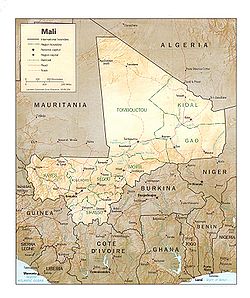
Geography of Mali
About this schools Wikipedia selection
SOS Children, an education charity, organised this selection. A good way to help other children is by sponsoring a child
Mali is a landlocked nation in West Africa, located southwest of Algeria, extending south-west from the southern Sahara through the Sahel to the Sudanian savanna zone.
At about 1.2 million square kilometers, Mali is comparable in size to South Africa and is almost twice the size of the US state of Texas. Mali shares a total of 7,243 kilometers of land boundaries with seven bordering states: Algeria (1,376 kilometers) to the north and northeast, Niger (821 kilometers) to the east, Burkina Faso (1,000 kilometers) to the southeast, Côte d’Ivoire (532 kilometers) to the south, Guinea (858 kilometers) to the southwest, and Senegal (419 kilometers) and Mauritania (2,237 kilometers) to the west.
Topography
Mali's territory encompasses three natural zones: the southern cultivated Sudanese zone, central semiarid Sahelian zone, and northern arid Saharan zone. The terrain is primarily savanna in the south and flat to rolling plains or high plateau (200–500 meters in elevation) in the north. There are rugged hills in the northeast, with elevations of up to 1,000 meters. Desert or semi-desert covers about 65 percent of the country’s area. The Niger River creates a large and fertile inland delta as it arcs northeast through Mali from Guinea before turning south and eventually emptying into the Gulf of Guinea.
The Niger (with 1,693 kilometers in Mali) and Senegal are Mali’s two largest rivers. The Niger is generally described as Mali’s lifeblood, a source of food, drinking water, irrigation, and transportation.
The country's lowest point is on the Senegal River (23 m) and its highest point is Hombori Tondo (1,155 m).
Climate
Mali's climate ranges from subtropical in the south to arid in the north. The country is mostly dry, with 4–5 months of rainy season. In Bamako, at an elevation of 340 meters (1,115 ft) above sea level, temperatures generally range from 16 to 39 °C (60.8 to 102.2 °F). January is the coldest month, with temperatures ranging from 16 to 33 °C (60.8 to 91.4 °F), and April is the hottest month, with temperatures averaging 34 to 39 °C (93.2 to 102.2 °F). Annual precipitation in Bamako averages 1,120 millimeters (44.1 in). The driest months are December and January with zero rainfall. The wettest month is August, which averages 220 millimeters (8.7 in) of rainfall. Most of the country receives negligible rainfall, and droughts are a recurring problem. During dry seasons, a hot, dust-laden harmattan haze is also common. Flooding of the Niger River occurs regularly in the rainy season (approximately June/July–November/December).
Geology
The area of Mali consists mostly of vast flatlands of granite and shale covered by sandstone and alluvial quartz. Mali extends over two main geological structures, the West African craton in the west and the Tuareg shield in the southeast, which came together at the end of the Precambrian era between 600 and 550 million years ago. The suture zone is to the west of the Adrar des Ifoghas mountains. The underlying rocks of the West African craton are covered in the northwest by sediments of the Taoudeni basin, with two main outcrops of crystalline rocks in the northern Reguibat shield in Mauritania and the southern Leo shield which includes the Bougouni and Kaneiba outcrops, both of which contain valuable minerals. There may also be petroleum reserves in the Taoudeni basin.
Land use
Sixty-five percent of Mali’s land area is desert or semi-desert. According to estimates in 1998, only 3.8 percent of Mali’s area can be classified as arable land, and less than 0.1 percent was planted to permanent crops in that year. Mali was estimated to have 1,380 square kilometers of irrigated land in 1998.
Environmental issues
Mali faces numerous environmental challenges, including desertification, deforestation, soil erosion, drought, and inadequate supplies of potable water. Deforestation is an especially serious and growing problem. According to the Ministry of the Environment, Mali’s population consumes 6 million tons of wood per year for timber and fuel. To meet this demand, 400,000 hectares of tree cover are lost annually, virtually ensuring destruction of the country’s savanna woodlands.
Mali is a party to international treaties on Biodiversity, Climate Change, Desertification, Endangered Species, Law of the Sea, Ozone Layer Protection, and Wetlands. It has signed, but not ratified: the Kyoto Protocol and the Nuclear Test Ban.
Natural hazards
Natural hazards in Mali include:
- Desert sandstorms in the north
- Dust-laden harmattan wind is common during dry seasons, bringing a dust haze which may ground aircraft and damage computers and sensitive electronics and machines, as well as aggravating respiratory diseases.
- Recurring droughts
- Bushfires in the south
- Occasional floods, for example in July 2007.
- Tropical thunderstorms in the south, which may bring wind and lightning damage as well as flash floods.
- Occasional Niger River flooding



